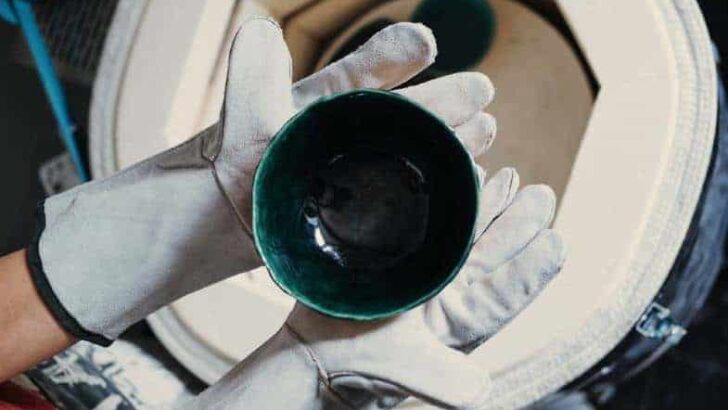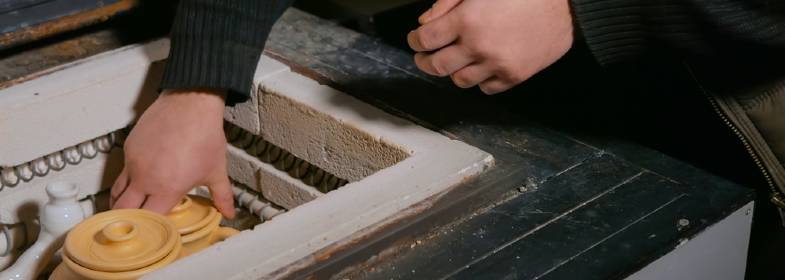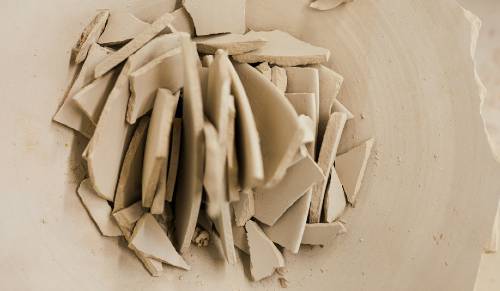Your cart is currently empty!
What Temperature Can You Open a Kiln? – A Hot Topic
Published:
Last Updated:

Affiliate Disclaimer
As an affiliate, we may earn a commission from qualifying purchases. We get commissions for purchases made through links on this website from Amazon and other third parties.
Most of us have been there, your kiln is coming to the end of the cool down, and you are itching to open it up. You may have heard about potters unloading their kilns early. Perhaps this has left you wondering what temperature can you open a kiln without causing clay carnage. This article looks at exactly that question.
Kiln manufacturers give different guidelines about what temperature you can open a kiln. Their recommendations usually range between 125 and 250F. A good rule of thumb is to open your kiln when it is at room temperature. That is when the outside of the kiln feels warm rather than hot.
In many areas of pottery and ceramics, what manufacturers recommend and what potters do can be quite different. The official line on what temperature you can open a kiln is generally more conservative than what potters actually do. Let’s have a look at what is recommended by some key kiln manufacturers and suppliers:
At What Temperature Can You Open a Kiln? – The Official Line
Having done some research across the board, I found the temperatures that some major suppliers recommend opening your kiln. This is what I discovered:
| Kiln Maker / Supplier | Temp You Can Open Kiln |
|---|---|
| Skutt L&L Kilns Paragon Kilns | Below 125 Below 250 Room Temperature |
Most makers and suppliers understandably err on the side of caution when making recommendations around this question. They don’t want you to hurt yourself, and they don’t want your pottery or kiln to be damaged. So, the advice is generally to wait as long as you can before you open up. And also, to unload the kiln when the pottery is cool enough to touch by hand.
Also, it’s usually recommended that you open the lid after glazing at a lower temperature than after a bisque fire. Glaze is vulnerable to crazing and losing its vibrance if the kiln is opened at too high a temperature. The closer the kiln is to room temperature after a glaze fire, the better.
What Temperature Can You Open a Kiln – In the Real World!
But potters are often strong-minded (I speak for myself here too), and they don’t always do what is recommended.
Many potters will have their own opinions and practices when it comes to deciding what temperature to open a kiln. It’s not uncommon for potters to start to open their kiln at 500F or even higher temperatures.
Some potters will take the plugs out of the peep holes at around 700F. Then when the temperature has dropped to around 400F, they crack the kiln lid and prop it open an inch. It’s quite common practice to use a piece of fire brick or a kiln prop to crack the lid.
As the temperature drops, they will slowly increase the width of the crack until it’s around 3 inches wide. Then finally they will open the kiln lid fully. Sometimes potters will get their heat-resistant gloves on and start unloading the kiln at 300F.
This scenario varies from person to person. Generally, potters will have different temperatures at which they open peep holes, crack the lid, and unload their kiln. But the temperatures are often higher than what is officially recommended.

However, this is not the case across the board. Other potters will report waiting until their kiln has all but fully cooled before they open it up. This is sometimes because they have a relaxed personality and feel that they are in no rush.
Others have had the disappointing experience of damaging their pottery by rushing to unload their ware.
I have to say that I’m in the latter category. When it comes to opening my kiln, I do tow the official line and wait until it’s at room temperature. And here are some of the reasons why…
Some of the Risks of Opening a Kiln When it’s Hot
Clay and glazes undergo very significant physical and chemical changes as they are being fired. This is stressful for the clay and the glaze and they have to be taken through some of the different stages carefully.
One of the things that happen when the ceramics are hot is that it has expanded. As it cools it contracts, but it needs to do this gradually to avoid putting it under too much stress.
There are several reasons why cooling too quickly can disrupt this process. Here are some of the key factors:
Thermal Shock
When a piece of ceramic ware is heated in a kiln, its volume increases (source). When the pottery is still greenware and has not yet become ceramic, it manages this change in volume relatively easily.
However, once it is ceramic, it is brittle. As a result, sudden shifts in temperature which cause it to contract quickly put it under a lot of stress.
One of the ways ceramics can respond to being put under intense internal stress is to crack or shatter. There is simply too much tension across the piece to hold together and it will break along its weakest lines.
This is one of the reasons that plates and platters are vulnerable to cracking. Because of their large surface areas, they have to manage a lot of internal tension as they undergo temperature changes.
If the kiln is still hot, and you open the lid, the temperature in the kiln will drop suddenly. As a result, your pottery is more likely to become a victim of thermal shock.

Glazes can also suffer if they are subject to thermal shock. A sudden drop in temperature can cause crazing. Potters also report that their glazes can lose some of their intensity and luster if cooled too sharply.
It’s worth bearing in mind, that it’s not just your pottery that suffers. Kiln bricks are also made of ceramic and find continual sharp changes in temperature stressful. They can crack as a result of these abrupt shifts. In addition to this, opening your kiln lid too early can also shorten the life expectancy of your elements.
In addition to thermal shock, there are another couple of stress points for ceramics as they cool down. These are the quartz inversion and the cristobalite inversion.
The Quartz Inversion
At around 1064F (573C) the quartz content of clay expands sharply. This is known as the quartz inversion. The expansion happens as the clay heats up and as it cools down. That is why it is called an inversion.
As mentioned earlier, once the clay has become ceramic, it is more brittle and rigid. Once brittle, ceramics find it harder to cope with changes in volume. This means that your pottery is more vulnerable to cracking as it passes through this temperature window.
The quartz inversion happens during a 122F (50C) window. This window centers around the 1064F (573C) mark (source). By cracking the lid on your kiln at this temperature, you are putting the ceramics under even more stress.
The chances of your pottery cracking during the quartz inversion are increased if there’s a temperature differential across your ceramics.
Let’s say it’s a larger piece of pottery and part of it is at 1112F and the other is 1064F. If this is the case, the cooler area will be expanding, whilst the hotter area is not. This creates a lot of internal tension across the piece and it may well crack.
So, creating any kind of cool spot in your kiln around this window can make your pottery more vulnerable. That is why you’re advised to keep the peep holes on your kiln plugged until the kiln is much cooler.
| Ceramic Volume Change | Temp F | Temp C |
|---|---|---|
| Quartz Inversion Cristobalite Inversion | 1064F 428F | 573C 220C |
The Cristobalite Inversion
Even if you get your ceramics through the quartz inversion, you are not necessarily out of the woods. Some, though not all, ceramics contain cristobalite. Cristobalite also goes through changes similar to the quartz inversion.
The difference with the cristobalite inversion is that it happens more sharply than the quartz inversion (source). Cristobalite changes volume in an 86F window, that centers around the temperature of 428F.
When the kiln is cooling through this window if cristobalite is present the ceramics will shrink sharply. On the one hand this contraction is seen as beneficial because it can help compress glazes and prevent crazing.
On the other hand, like the quartz inversion, it does put the ceramics under strain. If you are opening your kiln up around this temperature window, you are adding to this strain.
The Type of Clay Being Used
It’s worth bearing in mind that certain clays can cope with sharp shifts in temperature more successfully than others. For example, raku clay is designed to cope well with thermal shock. So, the kind of clay body and glaze you are using will affect what temperature you can open a kiln.
Opening a Kiln When it’s Still Hot
In spite of the above, potters do open their kilns when they are hotter than recommended by the supplier. If you are one of those potters with itching fingers, then it’s good to remember the following:
- It’s a good idea to open it in stages. Most potters will take the plugs out of the peep holes first. Once it has cooled down a little more they will crack the kiln lid, widening the crack gradually over time.
- Some potters like to peek in the kiln around 350 or 325F to check their glazes. If you do this, and you have a downdraft vent, remember to turn the vent off first. Leaving the vent on will draw cold air into the kiln and will cause the temperature to drop more rapidly.
- Wear safety glasses suitable for kiln use or welding when you look inside a kiln.
- If you hear a ‘pinging’ sound when you open the kiln, your kiln is too hot to open. The noise that you are hearing is your glaze contracting and cracking as it shrinks over the ceramic body.
Final Thoughts
The sensible answer to the question, what temperature can you open a kiln, is to consult your kiln supplier’s manual. These recommendations will vary around a narrow margin in the region of 125-250F. Essentially, the longer you can leave your kiln to cool the better. If you can wait until its room temperature, you eliminate the risk of any problems.



